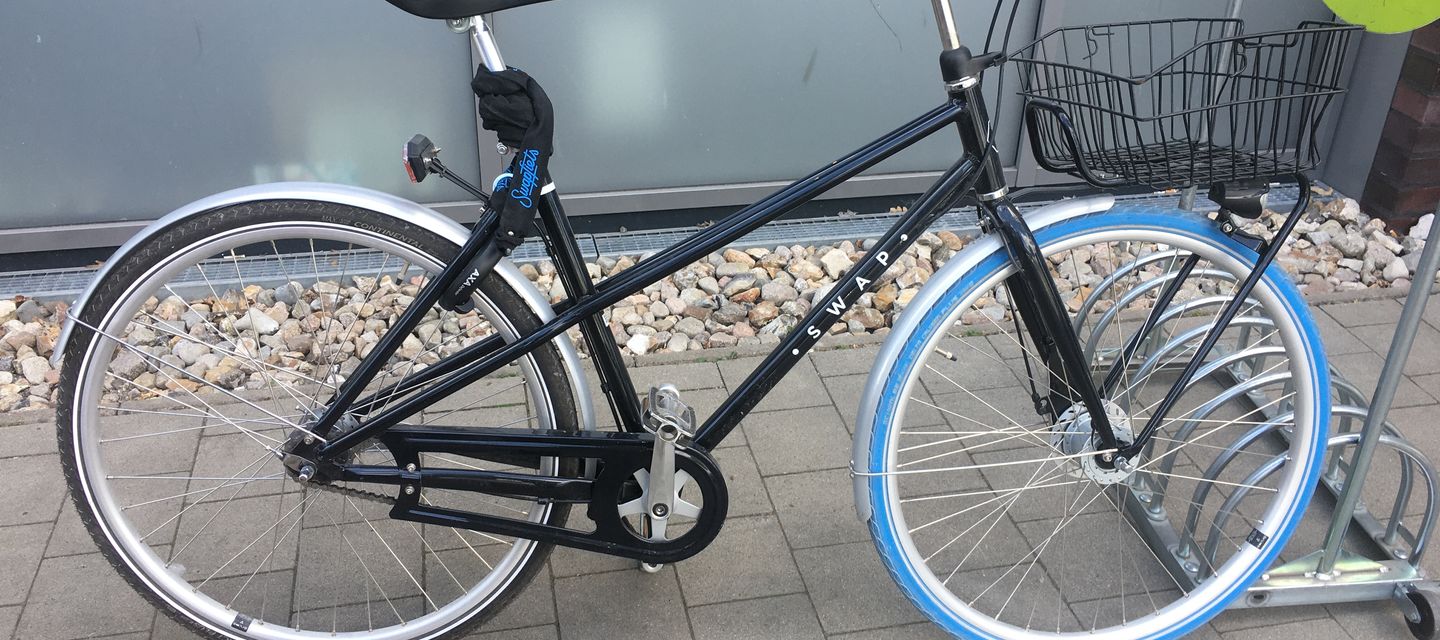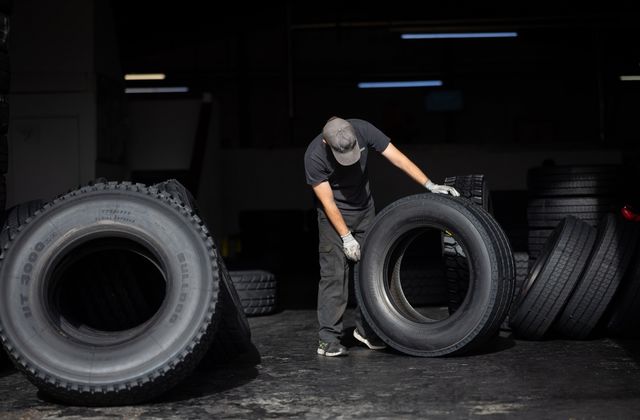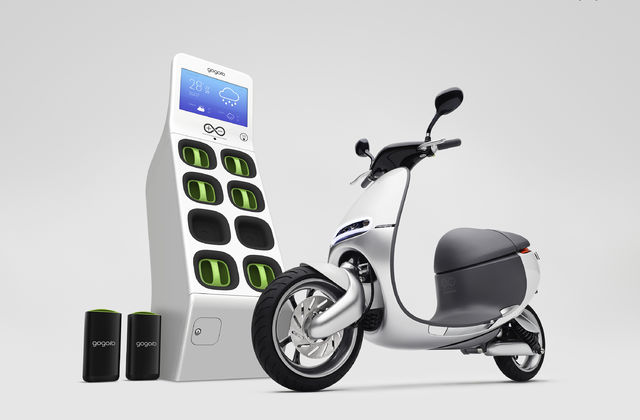What is it? Swapfiets offers a bike subscription-based membership service, where “for a fixed amount per month you receive a Swapfiets and we make sure that your Swapfiets always works” (Swapfiets, 2020a).
Why is this important? The European Environment Agency (2019) estimates that “in 2017, 27% of total EU-28 total GHG emissions came from the transport sector (22% if international aviation and maritime emissions are excluded)”. Bikes are a sustainable, healthy and pollution-free mode of transport. Further, as observed during the Covid-19 pandemic, use of public transport was actively discouraged by many governments. Having a hassle-free bike subscription service can be an important alternative to owning a personal car. Also, Swapfiets’ iconic blue tire and branding discourage bike theft (which can be a hindrance to bike ownership and use), and thus encourage more people to use a bike (Ma et al., 2020; Salvador, 2018).
Main resource strategy: Slowing the loop– Providing bikes-as-a-service, and ensuring products have multiple use cycles before their end-of-life, by providing good repair services
Other resource strategies: Closing the loop – Swapfiets is currently considering multiple strategies to ensure the end-of-life of its bikes are circular.
Business model strategies:
- Value Proposition: Subscription-based membership service for bikes.
- Value Creation & Delivery: Customers can sign up for the service by filling a form on the website. For a fixed amount per month, users receive a bike, and get continuous free service from the company for the duration of their subscription. Customers have exclusive access to their assigned bike, are given a unique key and lock, and can also customize their bikes - as long as the modifications are not permanent - thus giving them a sense of ownership to their bike.
- Value Capture: The bikes come fully equipped with lights, reflectors and 2 good-quality locks. Swapfiets promises to either repair or replace a broken bike within 48 hours, anywhere in the city. The fee paid starts from EUR 13.50/month (for students) for the basic bike, and can go up to EUR 75/month for the new e-bikes that were launched recently by the company.
Strategies for degrowth/ sufficiency (based on sufficiency strategies from Niessen & Bocken, 2021):
- Awareness-raising: Swapfiets raise awareness, for instance by running a PR campaign to encourage members to change their habits, 'Consume less, Use more', and switch to cycling.
- Design & Green alternative: They design their bicycles to be durable and easily reparable to ensure many use circles. The vehicles are also made out of sustainable materials and Swapfiets services encourage a low-emission form of travel, making cycling accessible and inclusive.
- No ownership: The Swapfiets bicycle and scooter subscription service includes repair and maintenance by Swapfiets with the members enjoying the benefits of riding the vehicle while Swapfiets retains ownership.
Business model experimentation practices: Customer interviews; one question surveys, A/ B split tests of new marketing messages; collaboration with partners to test new services.
Tools, methods and approaches used: Database of knowledge on repairs and maintenance feeding into experiments; community of customers, and newsletters; A/B test with customer cohorts combined with customer retention algorithm.
Sustainability outcomes: Swapfiets deluxe is estimated to operate at ‘88% circularity’ with about 9% entering the system as virgin materials and 3% leaving it as waste (Partners for Innovation, 2020). This high rate is achieved through the return rate of Swapfiets bicycles, extensive repairs done to maintain service quality and re-use or remanufacture of components (Partners for Innovation, 2020). The Swapfiets deluxe is estimated to be 35% more sustainable compared to the reference bike (‘linear economy’ bike without service contract), the reason being the difference in the technical lifetime of the bicycles’ components, as the bike has been optimized to last longer needing less maintenance over time (Partners for Innovation, 2020).
Swapfiets also reached a milestone of 200,000 active users in June 2020, in their markets across the Netherlands, Germany, Belgium and Denmark (Swapfiets, 2020b). They now have plans to expand to the UK, Italy and France (Swapfiets, 2020c). This has the potential to allow people to shift more easily to using bikes for urban mobility.
Sources:
European Environment Agency. (2019). Indicator Assessment: Greenhouse gas emissions from transport in Europe. Accessed 7 December 2020 at: https://www.eea.europa.eu/data-and-maps/indicators/transport-emissions-of-greenhouse-gases/transport-emissions-of-greenhouse-gases-12
Ma, X., Yuan, Y., Van Oort, N., Hoogendoorn, S., (2020). Bike-sharing systems’ impact on modal shift: A case study in Delft, the Netherlands. Journal of Cleaner Production, 120846259, 259. DOI:10.1016/j.jclepro.2020.120846
Partners for Innovation (2020) LIFE-CYCLE ASSESSMENT & CIRCULARITY OF SWAPFIETS (life cycle assessment, commissioned by Swapfiets).
Salvador, Dy Elmer. (2018). Bike sharing, Swapfiets and a sustainable city. United Nations University. Accessed 7 December 2020 at: https://tinyurl.com/y2nwyhev
Swapfiets. (2020a). About Us. Accessed 18 November 2020 at: https://swapfiets.nl/en/about/
Swapfiets. (2020b). International growth Swapfiets sets a new milestone of 200,000 customers. Accessed 18 November 2020 at: https://news.swapfiets.com/nl-NL/189804-internationale-groei-swapfiets-zorgt-voor-nieuwe-mijlpaal-van-200-000-klanten
Swapfiets. (2020c). Swapfiets continues to expand in Europe. Accessed 18 November 2020 at: https://news.swapfiets.com/nl-NL/190131-swapfiets-breidt-verder-uit-in-europa
***
About project Circular X
Project Circular X is about ‘Experimentation with Circular Service Business Models’. It is an ambitious research project funded by the European Research Council (ERC) which supports top researchers from anywhere in the world. Project CIRCULAR X runs from 2020-2025. The project is led by Principal Investigator (PI) Prof Dr Nancy Bocken, who is joined by a multidisciplinary team of researchers at Maastricht Sustainability Institute (MSI), Maastricht School of Business and Economics, Maastricht University. The project cooperates with businesses who want to innovate towards the circular economy.
Project Circular X addresses a new and urgent issue: experimentation with circular service business models (CSBMs). Examples of such new business models include companies shifting from selling products to selling services and introducing lifelong warrantees to extend product lifetimes. However, CSBMs are far from mainstream and research focused on experimentation is little understood. The research aims to conduct interdisciplinary research with 4 objectives:
- Advancing understanding of CSBMs; their emergence and impacts
- Advancing knowledge on CSBM experimentation
- Developing CSBM experimentation tools
- Designing and deploying CSBM experimentation labs
Funding source
This project has received funding from the European Research Council (ERC) under the European Union’s Horizon 2020 research and innovation programme, grant agreement No. 850159.
Use of this information
When you cite this publication, please use the following source:
Circular X (2021) Case study: Swapfiets - Bike Subscription Model. Accessed from www.circularx.eu



